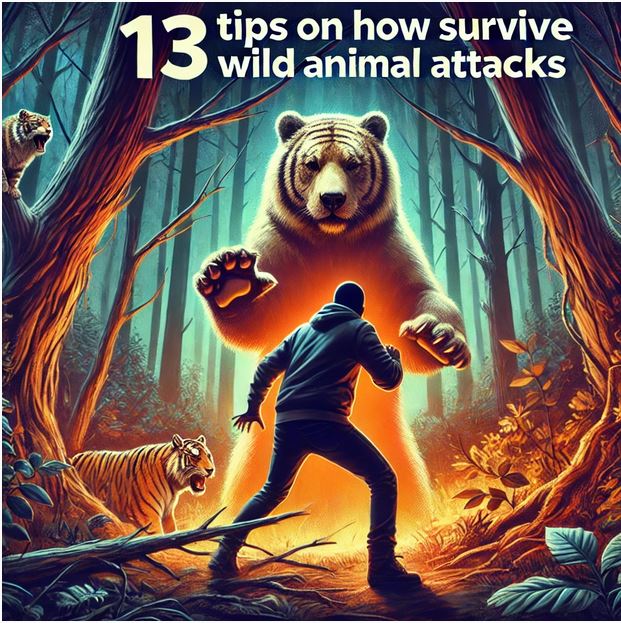Your Cart is Empty
13 Essential Tips to Survive Wild Animal Attacks | Stay Safe in the Wild
14 Jan, 2025 11

13 Tips on How to Survive Wild Animal Attacks
Introduction
Imagine this: you're hiking through a dense forest, soaking in the beauty of nature, when suddenly, you lock eyes with a wild animal. Your heart pounds, adrenaline rushes, and you realize you're not at the top of the food chain anymore. How would you react? Knowing what to do in these situations could save your life. Here are 13 essential tips to survive wild animal encounters.
1. Stay Calm and Assess the Situation
Panic is your worst enemy. Most animals are more scared of you than you are of them. Staying calm can prevent an escalation. Deep breaths can help regulate your body language, which animals often interpret as threatening or submissive.
2. Understand Animal Behavior
Learn the general behaviors of animals you may encounter in your region. For example, bears might bluff-charge to intimidate, while mountain lions stalk silently. Knowing these patterns helps you respond appropriately.
3. Avoid Surprising Wildlife
Many attacks happen because the animal feels startled or cornered. Make noise while hiking—clap, talk loudly, or wear bells. This warns animals of your presence and gives them time to move away.
4. Maintain a Safe Distance
If you spot a wild animal, don’t approach. Respect the “rule of thumb”: hold your thumb out at arm's length and cover the animal. If it’s still visible, you’re too close.
5. Carry and Know How to Use Safety Tools
Always have essential tools like bear spray, whistles, or air horns. These can deter animals and provide you with precious moments to escape. Practice using these tools so you're not fumbling in an emergency.
6. What to Do If You Encounter a Bear
- Grizzly Bears: If a grizzly bear charges, lie flat on your stomach, cover your neck, and play dead. Do not run—it can trigger their chase instinct.
- Black Bears: Fight back if attacked; they’re less likely to persist if met with resistance.
- Pro Tip: Never run downhill from a bear—it’s a myth they can’t run downhill effectively.
7. Surviving a Mountain Lion Encounter
Mountain lions are ambush predators. If you encounter one:
- Make yourself appear larger by raising your arms and standing tall.
- Maintain eye contact and back away slowly.
- If it attacks, fight back aggressively with sticks, rocks, or whatever you can grab.
8. Dealing with Wolves or Coyotes
Wolves and coyotes rarely attack humans, but if they do:
- Make yourself appear larger and louder.
- Do not run; they may see you as prey.
- Throw objects to scare them off.
9. Escaping from an Alligator or Crocodile
These reptiles are ambush predators.
- If one approaches you, back away slowly while maintaining eye contact.
- In water, swim in a zigzag pattern to confuse the predator.
- If attacked, target their sensitive eyes and nostrils.
10. Encounters with Snakes
- Prevention: Watch your step, especially in tall grass or rocky areas.
- If Bitten: Stay calm, limit movement, and seek medical attention immediately.
- Avoid trying to suck out venom or using a tourniquet—it’s outdated advice.
11. Moose Attacks: Nature’s Gentle Giants Aren’t So Gentle
Moose are unpredictable and easily agitated.
- Stay at least 50 feet away.
- If it charges, run to cover—trees or large objects can shield you.
- Avoid direct eye contact; it may interpret this as a challenge.
12. Escaping from Sharks in Open Water
- Stay calm and avoid splashing excessively—it mimics distressed prey.
- If attacked, aim for the eyes or gills, as these are the most sensitive areas.
- Keep your movements deliberate and slow to avoid drawing attention.
13. The Golden Rule: Prevention is Better Than Cure
The best way to survive a wild animal attack is to avoid one altogether.
- Research wildlife in the area before venturing out.
- Always hike with a buddy, as animals are less likely to attack groups.
- Secure your food and garbage to prevent attracting animals.
Conclusion
Nature is breathtakingly beautiful, but it demands respect. By understanding how to react during wild animal encounters, you not only increase your chances of survival but also contribute to the harmonious coexistence of humans and wildlife. Remember, these animals aren’t villains—they’re simply trying to survive, just like you.
Stay informed, stay prepared, and stay safe.




